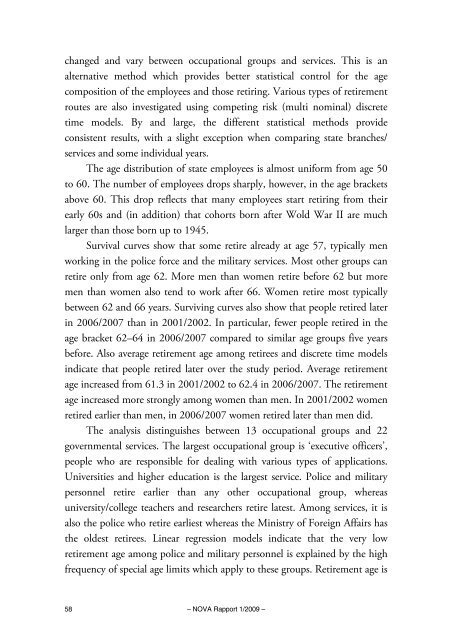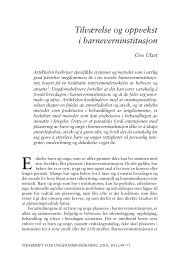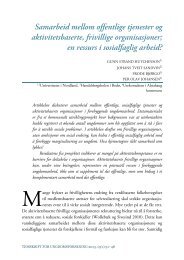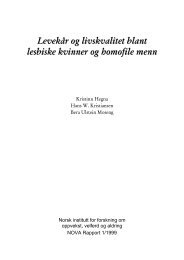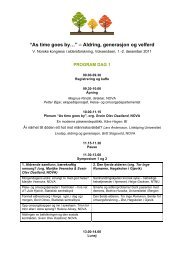Avgangsalder og pensjoneringsmønster i staten - Nova
Avgangsalder og pensjoneringsmønster i staten - Nova
Avgangsalder og pensjoneringsmønster i staten - Nova
You also want an ePaper? Increase the reach of your titles
YUMPU automatically turns print PDFs into web optimized ePapers that Google loves.
changed and vary between occupational groups and services. This is an<br />
alternative method which provides better statistical control for the age<br />
composition of the employees and those retiring. Various types of retirement<br />
routes are also investigated using competing risk (multi nominal) discrete<br />
time models. By and large, the different statistical methods provide<br />
consistent results, with a slight exception when comparing state branches/<br />
services and some individual years.<br />
The age distribution of state employees is almost uniform from age 50<br />
to 60. The number of employees drops sharply, however, in the age brackets<br />
above 60. This drop reflects that many employees start retiring from their<br />
early 60s and (in addition) that cohorts born after Wold War II are much<br />
larger than those born up to 1945.<br />
Survival curves show that some retire already at age 57, typically men<br />
working in the police force and the military services. Most other groups can<br />
retire only from age 62. More men than women retire before 62 but more<br />
men than women also tend to work after 66. Women retire most typically<br />
between 62 and 66 years. Surviving curves also show that people retired later<br />
in 2006/2007 than in 2001/2002. In particular, fewer people retired in the<br />
age bracket 62–64 in 2006/2007 compared to similar age groups five years<br />
before. Also average retirement age among retirees and discrete time models<br />
indicate that people retired later over the study period. Average retirement<br />
age increased from 61.3 in 2001/2002 to 62.4 in 2006/2007. The retirement<br />
age increased more strongly among women than men. In 2001/2002 women<br />
retired earlier than men, in 2006/2007 women retired later than men did.<br />
The analysis distinguishes between 13 occupational groups and 22<br />
governmental services. The largest occupational group is ‘executive officers’,<br />
people who are responsible for dealing with various types of applications.<br />
Universities and higher education is the largest service. Police and military<br />
personnel retire earlier than any other occupational group, whereas<br />
university/college teachers and researchers retire latest. Among services, it is<br />
also the police who retire earliest whereas the Ministry of Foreign Affairs has<br />
the oldest retirees. Linear regression models indicate that the very low<br />
retirement age among police and military personnel is explained by the high<br />
frequency of special age limits which apply to these groups. Retirement age is<br />
58<br />
– NOVA Rapport 1/2009 –


